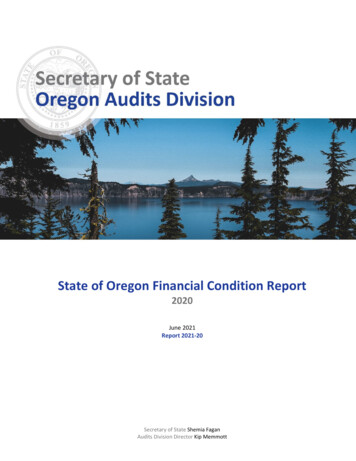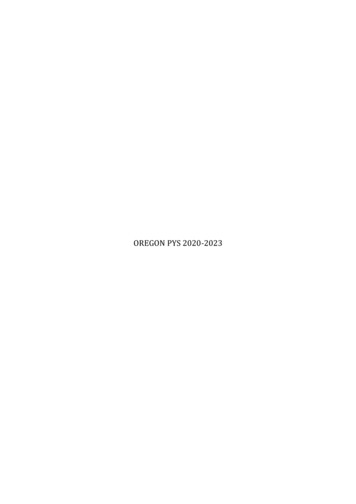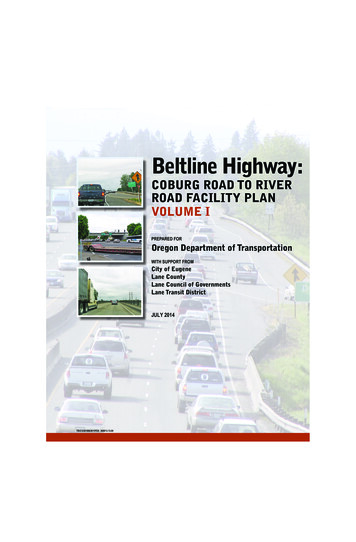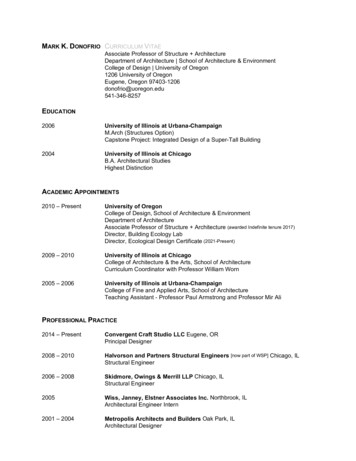
Transcription
State of Oregon Financial Condition Report2020June 2021Report 2021-20Secretary of State Shemia FaganAudits Division Director Kip Memmott
Office of the Secretary of StateAudits DivisionShemia FaganSecretary of StateKip R. Memmott, MA, CGAP, CRMADirectorCheryl MyersDeputy Secretary of State255 Capitol St. NE, Suite 500Salem, OR 97310503-986-2255Dear fellow Oregonians:In these unprecedented times, we are increasingly aware that Oregon state government plays amajor role in the lives of Oregonians. It provides vital services to a growing population in anenvironment of limited financial resources. Maintaining sound financial condition is key tosustaining and improving services. Various indicators can provide crucial information for decisionmakers, enabling them to capitalize on opportunities, tackle challenges, and effectively manage thefinancial condition of the state.Accordingly, this biennial report presents selected high-level historical indicators of Oregon’sfinancial condition for the period ending June 30, 2020, while also presenting available informationregarding the impacts of the COVID-19 pandemic and recent wildfires.Since our 2018 report, the following aspects of Oregon’s financial condition are worth noting: Human services continue to be the largest expenditures by program area at 15 billion, or42%, of state expenditures. Approximately 11.5 billion relates to the Medicaid program,with 8.4 billion federally funded through reimbursements, which includes an additional6.2% of federal funding from January to June 2020 in response to the COVID-19 pandemic.Education expenditures by K-12 institutions were 7.9 billion, with state funding being theprimary revenue source. Revenue shortfalls due to the COVID-19 pandemic weresupplemented by a 400 million withdrawal from the Education Stability Fund to maintaincurrent service levels.Unemployment insurance expenditures increased to 4.7 billion as a direct result of theCOVID-19 pandemic and stay-at-home orders. Despite this significant increase,unemployment insurance cash balances available to pay future claims only reduced 279million due to implementation of several new federally funded programs.Oregon’s unhoused population decreased by approximately 1,200 people to 14,600;however, the number of unhoused minors has more than doubled since 2011, presentingchallenges to identify and address the needs of the unhoused population.The COVID-19 pandemic and historic wildfires created an unprecedented need for stateservices immediately before and extending beyond the end of the state’s fiscal year. Wehave included a section to provide available information and will continue to provideupdated information as it becomes available in future reports.Please give thoughtful consideration to the following information, as responsible governance of therelated resources will pay dividends for all Oregonians.Sincerely,Shemia FaganSecretary of State
Fiscal Year 2020State of Oregon Financial Condition ReportOregon state government plays a major role in the lives of Oregonians. It provides vital services to a growingpopulation in an environment of limited financial resources. Maintaining sound financial condition is key tosustaining and improving services. Various indicators can provide key information for decision-makers,enabling them to capitalize on opportunities, tackle challenges, and manage financial condition timely andeffectively. While fiscal year 2020 ended June 30, 2020, this report does include information regarding theCOVID-19 pandemic and wildfires that occurred throughout 2020.Expenditures by ProgramRevenues (in billions)Human Services continues to be the largest program,with the majority of expenditures for the Medicaidprogram, which assists low-income families in payingfor medical care. Education spending includes K-12schools, universities, and community colleges.The state’s main revenue sources are taxes,federal revenue, and charges for services. Since2018, tax revenues have increased about 853million while federal revenues have increased 4.3billion, primarily related to COVID-19 pandemicassistance.Oregon’s population andpersonal income percapita continued toexperience growth.Unemploymentinsurance expendituresincreased, however cashbalances only decreased6%.The Rainy Day Fundincreased and remainsavailable to weathereconomic downturns anduncertainties.The state’s pensionliability is about 77%funded, increasing theunfunded liability toabout 5.9 billion.
Table of ContentsIntroductionRevenuesTotal RevenuesTax RevenuesFederal RevenuesCharges for ServicesRestricted and Unrestricted Revenuespg. 1pg. 2pg. 3pg. 4pg. 4Total ExpendituresGeneral Fund ExpendituresHuman ServicesK-12 EducationPublic UniversitiesCommunity CollegesUnemployment InsuranceTransportationPublic SafetyUnhousedOtherpg. 5pg. 6pg. 6pg. 7pg. 8pg. 9pg. 10pg. 11pg. 12pg. 13pg. 13Long-Term DebtDebt Per CapitaFuture Debt Servicepg. 14pg. 15pg. 15Governmental Fund BalanceOregon Rainy Day FundState Retirement LiabilitiesEmployee Health Care CostsTax Expenditurespg. 16pg. 16pg. 17pg. 18pg. 19PopulationAge DemographicsPovertyUnhousedOregon Health PlanSupplemental Nutrition Assistance ProgramPercent UnemployedOregon BusinessesPer Capita Personal IncomeViolent Crime RateProperty Crime Ratepg. 20pg. 20pg. 21pg. 21pg. 22pg. 22pg. 23pg. 23pg. 23pg. 24pg. 24COVID-19 PandemicWildfirespg. 25pg. 28pg. 30ExpendituresLong-Term DebtFiscal HealthDemographics2020 Significant EventsAppendix – Oregon Expenditures by Program Area and State Agency
IntroductionObjective, Scope, MethodologyThe objective of this report is to provide information for the evaluation of the financial condition ofthe State of Oregon by decision-makers, the Oregon Legislature, and Oregonians. To complete ourobjective, we used select measurements from the Financial Trend Monitoring System developed bythe International City and County Management Association.The data in the report generally covers a 10-year period from fiscal year 2011 through 2020. Unlessotherwise indicated, data is on a fiscal year basis (e.g., fiscal year 2020 represents July 1, 2019,through June 30, 2020). We express financial data in constant dollars to account for inflation byadjusting dollar amounts from each prior year to equal the purchasing power of money onJune 30, 2020. We used the Consumer Price Index for the West region, as reported by the Bureau ofLabor Statistics, U.S. Department of Labor.We reviewed information for reasonableness and consistency. However, we did not audit theaccuracy of the source documents or the reliability of the data in computer-based systems. Ourreview is not to give absolute assurance that all information is free from error. Rather, our intentwas to provide reasonable assurance the reported information presents a fair picture of the state’sfinancial condition. In addition, while the report offers financial highlights, it does not thoroughlydetermine the reasons for negative or positive performance. Explanations would require furtheranalysis.This report is for informational purposes and does not constitute an audit performed in accordancewith generally accepted government auditing standards.Data SourcesNearly all financial information is from the State of Oregon’s Comprehensive Annual FinancialReports. Additional information, such as environmental indicators, is from state and federalagencies and may present different time periods because it is only available on a calendar yearbasis. Some information useful to readers extends beyond the 10 fiscal years covered in the report.Resources used include the following:Oregon Department of Administrative ServicesOregon Department of EducationOregon Department of ForestryOregon Department of Human ServicesOregon Department of RevenueOregon Department of TransportationOregon Employment DepartmentOregon Health AuthorityOregon Higher Education Coordinating CommissionOregon Housing & Community Services DepartmentOregon Office of Economic AnalysisOregon Public Employees’ Retirement SystemOregon Secretary of StateOregon State TreasuryOregon State Lottery Comprehensive AnnualFinancial ReportState of Oregon Comprehensive Annual FinancialReportState of Oregon Single AuditUniversity of OregonOregon State UniversityPortland State UniversityWestern Oregon UniversitySouthern Oregon UniversityEastern Oregon UniversityOregon Institute of TechnologyPortland State University, Population ResearchCenterUnited States Bureau of Economic AnalysisUnited States Bureau of Labor and StatisticsUnited States Census BureauUnited States Department of Health and HumanServicesUnited States Department of Housing and UrbanDevelopmentUnited States Department of LaborUnited States Federal Bureau of Investigation
RevenuesTotal RevenuesRevenues are affected by economic and policychanges and determine the capacity of thegovernment to provide services to Oregonians.Total revenues have increased 20% since 2011and 9% since 2019.Chart 1: Total Revenues by SourceAdjusted for inflation (in billions), FY ended June 30 40 35.2 35 30 25 20 15 10 5 01112Taxes131415Federal Revenue1617181920Charges for ServicesOregon Secretary of State Report 2021-20 June 2021 Page 1
Tax RevenuesIn 2019, Oregon ranked 24th nationally in statetaxes collected per capita and fifth in terms ofpersonal income tax collections per capita, whichremains Oregon’s primary source of tax revenues.The Corporate Activity Tax (CAT) was adopted bythe Legislature in 2019 to provide additionalrevenues for education spending. The CAT is inaddition to the state’s current corporate incometaxes and resulted in an additional 420 million intax revenues in 2020.Other Taxes have increased 29% since 2018 relatedto increased marijuana tax revenues andinheritance tax collections. Oregon legalizedrecreational marijuana use in 2016; tax collectionswere 121 million and 156 million for 2019 and2020, respectively.Personal Income Tax Revenues and KickerWhen General Fund revenues, which are primarilycomprised of personal income taxes, exceedforecasted revenues by 2%, state law requires theexcess amount (referred to as the “kicker”) berefunded to taxpayers. Kicker amounts arerefunded to taxpayers through credits onsubsequent tax returns. As shown in Chart 3, the 1.6 billion refunded at the end of the 2017-19biennium resulted in a significant reduction ofpersonal income tax revenues in 2020. Kickerrefunds also occurred following the prior twobiennia when the state refunded 447 million and 489 million, respectively.Chart 2: Tax RevenuesAdjusted for inflation (in billions), FY ended June 30Note: Corporate Activity Tax applied only in FY20 16 14 12 10 8 6 4 2 01112131415Personal Income TaxCorporate Activity TaxTransportation Taxes1617181920Corporate Income TaxTobacco TaxesOther TaxesChart 3: Personal Income Tax RevenuesAdjusted for inflation (in billions), FY ended June 30 12 10 8 6 4 2 01112131415Personal Income Tax1617181920Kicker PaymentsOregon Secretary of State Report 2021-20 June 2021 Page 2
Federal RevenuesFederal revenues are grants and reimbursementsreceived from the federal government forprograms and services provided to eligiblerecipients and are often restricted in their use. Thestate received 5.4 billion from 2009 through 2020through the American Recovery and ReinvestmentAct (ARRA), the majority of which was received bythe end of 2012.In 2020, the state received 3.7 billion inadditional federal funding in response to theCOVID-19 pandemic. These congressional actionsincluded funding for expenditures resulting fromthe pandemic that were not previously budgeted,as well as expanded unemployment benefits.Federal Revenues by Program AreaThe state received about 16.2 billion in federalassistance in fiscal year 2020. This represented a 4.1 billion (34%) increase since 2019, and anoverall increase of 29% since 2011.Traditionally, the largest federal revenue sourceis the Medicaid program in the human servicesprogram area, accounting for approximately 8.4billion in 2020. The Unemployment Insuranceprogram significantly increased in 2020 as aresult of the COVID-19 pandemic, representingapproximately 3.3 billion in federal revenue.Chart 4: Federal RevenuesAdjusted for inflation (in billions), FY ended June 30 16 14 12 10 8 6 4 2 0111213141516Non-ARRA Federal Revenue1718ARRA1920COVIDChart 5: Fiscal Year 2020 Federal Revenues by Program(in billions)Other, 0.6UnemploymentCompensation, 3.3Transportation, 0.6Education, 0.8 16.2 billionNaturalResources, 0.3Economic andCommunityDevelopment, 0.3HumanServices, 10.3Oregon Secretary of State Report 2021-20 June 2021 Page 3
Charges for ServicesCharges for services are amounts collected fromcustomers, applicants, employers, and others whouse, purchase, or directly benefit from servicesprovided. In fiscal year 2020, charges for servicestotaled 5.4 billion and represented 15% of totalstate revenues. When omitting charges related tothe university system, which was reported as astate activity until 2015, charges for servicesincreased 123 million, or 2%, since 2011. Chargesfor services generally support services of theparticular program area, but those of the LiquorControl Commission and Lottery support services ofother program areas as well.Chart 6: Fiscal Year 2020 Charges for Services(in millions)Public SafetyTransportationNatural ResourcesLiquor ControlHuman ServicesUnemployment CompensationAll OtherLottery Operations 0Fund SupportRestricted and Unrestricted RevenuesThe Legislature has discretion over spendingGeneral Fund revenues. Of the 35.3 billion intotal state revenues in fiscal year 2020, 32% is inthe state General Fund with the majority availableto fund education, human services, and publicsafety programs. The remaining revenues arerestricted for specific purposes by grantagreements, the Oregon Constitution, or Oregonstatutes. About 67% of restricted revenues arefederal revenues that can be used only for federalprograms. Other significant restricted revenuesinclude motor fuel and other vehicle taxes. 300 600 900 1,200General Government SupportChart 7: Restricted and Unrestricted RevenuesAdjusted for inflation (in billions), FY ended June 30 40 30 20 10 011121314Restricted Revenues151617181920General Fund RevenuesOregon Secretary of State Report 2021-20 June 2021 Page 4
ExpendituresTotal ExpendituresExpenditures remained fairly steady from 2011 to2018, with increases in human servicesexpenditures from 2014 to 2016 due toimplementation of the Affordable Care Act (ACA).Expenditures increased beginning in 2019 as aresult of increased transportation and humanservices expenditures. The significant increase in2020 expenditures was related to the COVID-19pandemic response, most notably for humanservices and unemployment programs.Chart 8: Total State ExpendituresAdjusted for inflation (in billions), FY ended June 30 40 30 25 20 15In 2020, about 85% of the state’s 35.8 billion inexpenditures occurred in five areas: humanservices, education, unemployment compensation,transportation, and public safety. 35.8 3511121314151617181920Chart 9: Fiscal Year 2020 Total Expenditures by Program(in billions)Transportation, 1.9UnemploymentCompensation, 4.7Public Safety, 1.8Other, 5.4Education, 6.9 35.8 billionHumanServices, 15.0Oregon Secretary of State Report 2021-20 June 2021 Page 5
General Fund ExpendituresOf the state’s 35.8 billion in expenditures, 11.6billion were General Fund expenditures. Themajority of General Fund spending occurred inthree areas: education, human services, and publicsafety. These three programs accounted for 85% to88% of General Fund expenditures in each of thelast 10 years. Expenditures can either be directlyspent by state agencies or passed through to othergovernment units to provide services. For example,education expenditures are primarily passedthrough to local school districts, public universities,and community colleges to provide educationservices.Chart 10: Fiscal Year 2020 General FundExpenditures by Program(in billions)Other 0.2Interest 0.2Natural Resources 0.2Debt Service 0.2Judicial 0.4Administration 0.5Public Safety 1.3Human Services 2.9Education 5.8 0 2Direct StateHuman ServicesHuman services spending has steadily increased inthe last 10 years, with spending at 15 billion infiscal year 2020. Increases in 2015 were due toexpanded eligibility for the Medicaid program aspart of the ACA.In 2020, a total of 11.5 billion was spent forMedicaid. The state share of 3.1 billion represents32 cents of every state dollar — substantially morethan the 21 cents of every dollar spent in 2011.The Medicaid program compensates health careproviders for services for eligible individuals andthe state receives federal reimbursement for aportion of eligible Medicaid expenditures. 4 6Other Government Pass ThroughChart 11: Human Services ExpendituresAdjusted for inflation (in billions), FY ended June 30 16 14 12 10 8 6 4 2 011121314151617181920OtherMedicaid Expenditures - StateMedicaid Expenditures - FederalOregon Secretary of State Report 2021-20 June 2021 Page 6
K-12 EducationIn 1990, Oregon voters passed Ballot Measure 5,which phased in property tax limitations for localgovernments and shifted a significant portion ofthe responsibility for school funding to the state.In 2020, state funding provided for 58% of K-12expenditures and local funds provided 36%. Thestate distributes funding through the State SchoolFund (SSF), which is allocated across schooldistricts and educational service districts toachieve equal per-student funding. The formulaadjusts for cost differences through teacherexperience adjustments, transportation grants,and weighted student counts.Total K-12 public education spending was 7.9billion in 2020, an increase of 2% since 2019 and19% since 2011. The majority of educationspending at the district level, 7.3 billion, occurredin Instruction and Support Services categories,which relates to teaching students and services tofacilitate and enhance instruction.Chart 12: Education (K-12) Spending by Source 20112020Adjusted for inflation (in billions) 9 8 7 6 5 4 3 2 1 011121314State15Local1617181920FederalChart 13: 2020 Education (K-12) Expenditures by Category(in billions)Enrollment for K-12 has increased 4% since 2011,to approximately 583,000 students in 2020.SupportServices, 2.9Other, 0.5Instruction, 4.5Oregon Secretary of State Report 2021-20 June 2021 Page 7
Public UniversitiesThere are seven public universities in Oregon, thelargest of which are Oregon State University,Portland State University, and the University ofOregon. University expenditures focus oninstruction, research, public service, auxiliaryservices such as housing and dining, athletics,health services, and academic, student, andinstitutional support.The majority of university funding is tuition andgrants, with additional funding from the state’sGeneral Fund, Lottery funds, and other sources.The Public University Support Fund is the state’sprimary direct funding contribution for universityoperations and is allocated to the individualuniversities using the Student Success andCompletion Model, which includes missiondifferentiation, activity-based, and outcomesbased funding. Outcomes-Based Funding rewardsdegree and certificate completions by Oregonresident students, as well as completions byunderrepresented students (minority, low-income,rural, and veterans) and those in academicdisciplines in high-demand and high-reward fieldswith additional resources.Chart 14: Universities' Expenditures by Revenue SourceAdjusted for inflation (in billions), FY ended June 30 3.5 3.0 2.5 2.0 1.5 1.0 0.5 0.011121314151617181920General Fund and other Governmental sourcesTuition and other revenuesIn 2020, the universities received 541 millionfrom the General Fund and another 52 millionfrom other governmental sources.Since 2011, overall university enrollmentdecreased 3% to approximately 97,000 students in2020. Nonresident student populations increased24%, and resident student populations decreased14% since 2011. Despite the overall decrease inenrollment, the increased ratio of nonresident toresident students has resulted in a continualincrease in tuition revenues, due to nonresidenttuition being almost double the cost of residenttuition.Chart 15: Enrollment by Oregon Residency Status36%64%Resident StudentsNonresident StudentsOregon Secretary of State Report 2021-20 June 2021 Page 8
Community CollegesOregon has a network of 17 community collegeswith independently elected boards. These schoolsare considered local governments and receivedapproximately 334 million in state funding in2019 through the Higher Education CoordinatingCommission. 1 Since 2010, community collegesreceived approximately 53% of funding from localsources, such as tuition and property taxes, and27% from federal sources.State funding is provided through the CommunityCollege Support Fund, which includes funding forspecific program areas, such as distance learning,as well as proportional distributions based on thefull-time equivalent enrollment for Oregon, Idaho,Washington, Nevada, and California residents whotake part in coursework offered within Oregonboundaries.Community college enrollment has declined 37%since 2011, due in part to improving economicconditions encouraging people to remainemployed instead of seeking further education fora career change.1Chart 16: Community College Expenditures by Revenueand SourceAdjusted for inflation (in billions), FY year ended June 30 2.0 1.5 1.0 0.5 0.010111213Federal1415Local16171819StateChart 17: Community College EnrollmentNumber of Students (in thousands)40035030025020015010050022910 11 12 13 14 15 16 17 18 19 202019 is the most current information available for community colleges from the Higher Education Coordinating Commission.Oregon Secretary of State Report 2021-20 June 2021 Page 9
Unemployment InsuranceThe Unemployment Insurance program providespayments to eligible individuals who have losttheir jobs through no fault of their own.Employers are assessed a payroll tax based onemployee earnings, the funds from which areused to make benefit payments. When taxassessments exceed benefit payments, theunemployment compensation fund balanceincreases, building cash reserves to help weatherperiods of high unemployment. Unemploymentexpenditures significantly increased in 2020 as aresult of the COVID-19 pandemic response, whichclosed, or reduced the operating capacity of,many businesses beginning in March 2020.Federal pandemic response benefit paymentsrepresented 3.2 billion (67%) of total 2020unemployment expenditures. The majority offederal pandemic response payments, 2.7billion, were related to the Federal PandemicUnemployment Compensation program, whichprovided individuals an additional 600 per weekif they received any type of unemploymentinsurance benefit.Chart 18: Unemployment Insurance ExpendituresAdjusted for inflation (in billions), FY ended June 30 4.7 5.0 4.0 3.0 2.0 1.0 0.01112131415State1617Federal181920Chart 19: COVID-19 Federal UnemploymentInsurance Expenditures by Benefit ProgramFY ended June 30, 2020PandemicUnemploymentAssistance8.7%Federal 8% 3.2 billionOther2.2%Pandemic EmergencyUnemploymentCompensation1.1%The remaining unemployment insurance benefitpayments were paid with cash reserves that havebeen building since 2011; overall cash decreasedonly 6% in 2020.Chart 20: Unemployment Insurance Cash BalanceAdjusted for inflation (in billions), FY ended June 30 5.0 4.51 4.0 3.0 2.0 1.0 0.011121314151617181920Oregon Secretary of State Report 2021-20 June 2021 Page 10
TransportationTransportation expenditures consist of costs tomaintain, build, and repair Oregon’s network ofhighways, tunnels, and bridges. Transportationrevenues are primarily from the State HighwayFund, which includes constitutionally dedicatedhighway user taxes and vehicle registration taxes,in addition to various federal highway funds.Expenditures increased 11% since 2018, due topassage of the Keep Oregon Movingtransportation funding package in August 2017.This legislation included funding for road andbridge maintenance, better public transportation,and electric vehicle incentives as well asproviding additional funding to cities andcounties to complete local projects.Chart 21: Transportation ExpendituresAdjusted for inflation (in billions), FY ended June 30 2.0 1.95 1.5 1.011121314151617181920Distributions by the Oregon Department ofTransportation to cities and counties as requiredby statutes increased 8% since 2018 to 532million.Oregon Secretary of State Report 2021-20 June 2021 Page 11
Public SafetyThe Public Safety program provides services toensure the safety of Oregonians and theirproperty through police, military, courts, andcorrectional facilities. Nearly half of public safetyexpenditures were by the Department ofCorrections to operate 14 correctional facilities,which house approximately 13,150 adults incustody. The number of adults in custody inOregon’s prisons decreased 6% over the pastdecade and 10% since 2019. This decrease isprimarily attributed to COVID-19 pandemicfactors, such as correctional facility socialdistancing policies, delays in case processing, andchanges in crime patterns. Overall, the adultsleaving custody outnumbered those enteringcustody.The increase in expenditures in 2016 was due tothe Oregon Supreme Court ruling in Moro v. Stateof Oregon, which reversed a significant portion ofreductions and resulted in the recognition of 373 million in pension expenses in 2016.Expenditures remained stable from 2017 to 2019and increased in 2020 due to salary and pensioncosts.Chart 22: Fiscal Year 2020 Public Safety Expenditures by AgencyOthers4%OregonYouthAuthority9%Departmentof Justice16%MilitaryDepartment9% 1.96 billionOregon StatePolice13%Departmentof Corrections49%Chart 23: Public Safety ExpendituresAdjusted for inflation (in billions), FY ended June 30 2.0 1.5 1.0 0.5 0.011121314General Fund151617181920Other FundOregon Secretary of State Report 2021-20 June 2021 Page 12
Unhoused ExpendituresThe unhoused population in Oregon has decreased15% since 2011 to approximately 14,600 individuals;however, the minor unhoused population has grownfrom about 900 individuals in 2011 to about 2,000individuals in 2020. Housing assistance programs,such as the Emergency Housing, State Homeless andShelter Expansion programs, were established for theunhoused or those at risk of becoming unhoused, andare primarily funded with state resources. Theseprograms focus on helping low-income persons whoare unstably housed or have emergency needs andwork to reduce community poverty and ensureavailable shelter resources for the unhoused.Expenditures for programs to assist unhousedpopulations totaled 48.6 million in 2020. 2OtherGovernmental funds also support the operations ofother smaller agencies and programs. Examplesinclude expenditures for operations of the judicialsystem, economic development, and the preservationand maintenance of natural resources. See theappendix for a detail of expenditures by programarea and state agency.2Chart 24: Fiscal Year 2020 Unhoused Program Expenditures(in millions) 50 45Housing ShelterExpansion 40 35Housing CommunityServices Block Grant 30State HomelessAssistance Program 25 20Emergency HousingAssistance 15Other Programs 10 5 0Chart 25: All Other ExpendituresAdjusted for inflation (in billions), FY ended June 30 6 5.4 5 4 3 2111213141516Unhoused expenditures represent a new financial indicator and 10-year trend information will be presented going forward.17181920Oregon Secretary of State Report 2021-20 June 2021 Page 13
Long-Term DebtLong-Term Debt StructureThe issuance of long-term debt allows the state to acquiremajor assets and finance large projects such as buildings,bridges and highways, and prisons. An increase in debt,however, limits the state’s ability to react to currenteconomic conditions. When resources are committed topay fixed amounts for debt service, the ability to maintainservice levels becomes more difficult, especially whenrevenues decline.Oregon’s outstanding debt falls into four broadcategories:Revenue Bonds finance a variety of generalgovernment projects. Repayment is secured by apledge of specific revenues, such as highwayprojects using highway user taxes as the repaymentsource. The amount of revenue bonds outstandingas of June 30, 2020, was 4.6 billion.General Obligation Bonds finance a variety ofThe Oregon Constitution and state statutes limit the totalgeneral government projects. These bonds areamount of debt the state may incur, but individual agenciessecured by a pledge of the full faith, credit, andmay issue debt for specific programs pursuant to state law.taxing power of the state, and are limited to apercentage of the real market value of all taxableChart 26: Long Term DebtAdjusted for inflation (in billions), FY ended June 30real property in the state. The amount of generalobligation bonds outstanding as of June 30, 2020,was 6.1 billion, or 9.9% of the maximum allowed. 16DVA General Obligation Bonds issued by theDepartment of Veterans’ Affairs (DVA) financehousing loans for qualifying veterans. Veterans’home loan repayments fund the debt servicepayments for these bonds, but other state funds areavailable if DVA is unable to repay the bonds. Theamount of DVA general obligation bondsoutstanding as of June 30, 2020, was 393.5 million. 14 12 10 8 6 4 2 00002040608Revenue BondsOther GO Debt10121416DVA GO DebtCOPS1820Certificates of Participation are financingagreements used to purchase computer andtelecommunications systems and other state facilityprojects. The amount of certificates of participationoutstanding as of June 30, 2020, was 101 million.In fiscal year 2020, the state issued 1.3 billion ofnew debt to refund 1.3 billion of outstanding debtto reduce futur
Unemployment Insurance pg. 10 Transportation pg. 11 Public Safety pg. 12 Unhoused pg. 13 Other pg. 13 Long-Term Debt Long-Term Debt pg. 14 Debt Per Capita pg. 15 Future Debt Service pg. 15 Fiscal Health Governmental Fund Balance pg. 16 Oregon Rainy Day Fund pg. 16 State Retirement Liabilities pg. 17 Employee Health Care Costs pg. 18











